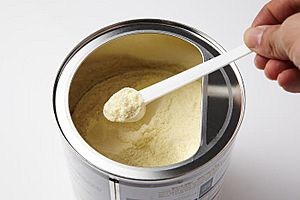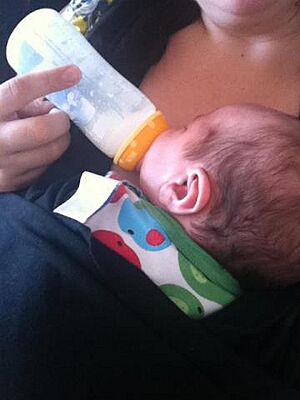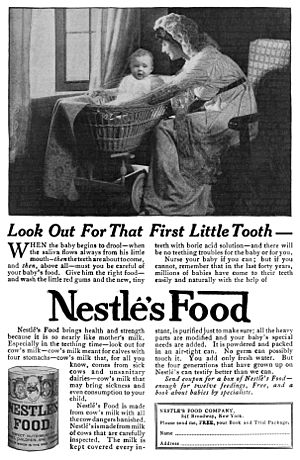Infant formula facts for kids
Infant formula, also called baby formula or baby milk, is a special food made for babies under 12 months old. It's usually given to babies using a baby bottle or a cup. This formula comes as a powder (mixed with water) or a liquid (ready to use or mixed with water).
Manufacturers try to make infant formula similar to a mother's milk, especially for babies around one to three months old. However, there are some differences in the nutrients. Most common formulas use cow's milk proteins (like whey and casein), vegetable oils for fat, and lactose for carbohydrates. They also include many vitamins and minerals.
Some formulas use soybean instead of cow's milk, especially for babies who might be allergic to cow's milk. There are also special formulas where the proteins are broken down into tiny pieces for babies with severe allergies.
Health organizations like the World Health Organization (WHO) say that infant formula, when made correctly, is a safe food and a good substitute for breast milk. However, they also stress that breastfeeding is very important for a baby's health, especially in the first six months.
In some parts of the world, especially in poorer areas, preparing formula can be risky. This is because there might not be clean water or ways to sterilize bottles. When formula is made in unclean conditions, babies can get very sick from illnesses like diarrhea or pneumonia. There have also been rare cases where certain germs in powdered formula caused serious illness in infants.
How Infant Formula is Made and What's Inside
Different Types of Formula
Infant formulas come in different forms to make it easy for parents to prepare them:
- Powder: This is mixed with water.
- Liquid Concentrate: This is a thicker liquid that needs to be mixed with water.
- Ready-to-Feed: This liquid formula is already prepared and doesn't need any mixing.
Parents or caregivers usually prepare the formula in small amounts and feed it to the baby with a cup or a baby bottle.
Here are the main types of infant formula:
- Cow's Milk Formula: This is the most common type. The cow's milk is changed to be more like breast milk.
- Soy-Based Formulas: These are often used if a baby is allergic to cow's milk or lactose. They are also an option if parents want to avoid animal products.
- Protein Hydrolysate Formulas: In these formulas, the proteins are broken down into much smaller pieces. They are for babies who can't handle cow's milk or soy formulas.
- Special Formulas: There are also specific formulas for babies born early (premature) or those with certain health problems.
It's very important to measure the powder or liquid concentrate exactly as the instructions say. If not, the baby might not get enough nutrients. All feeding equipment should be cleaned and sterilized before each use. If you prepare formula ahead of time, it must be kept cold in the refrigerator.
In some developing countries, formula is often prepared incorrectly. This can lead to babies becoming malnourished or getting sick with diseases like diarrhea and pneumonia. This happens because of a lack of clean water, sterile conditions, refrigeration, or education on how to prepare it safely. Sometimes, families might even dilute the formula to make it last longer, which means the baby doesn't get enough nutrients.
What Nutrients are in Formula?
Besides breast milk, infant formula is the only other milk product that doctors say is good for babies under one year old. Regular cow's milk, goat's milk, or other milks are not recommended for babies under 12 months. This is because a baby's body isn't ready to digest them properly, which can cause problems like diarrhea or poor nutrition.
Even though most infant formulas are made from cow's milk, the milk goes through special processing. This makes the proteins easier to digest and balances the whey and casein proteins to be more like human milk. Other important ingredients are added, and dairy fats are often replaced with fats from vegetables or fish.
In the United States, the Food and Drug Administration (FDA) makes sure that all infant formulas have certain nutrients. These include:
- Protein
- Fat
- Linoleic acid
- Many vitamins (A, C, D, E, K, B vitamins)
- Folic acid
- Pantothenic acid
- Calcium
- Minerals (like magnesium, iron, zinc, copper)
- Phosphorus
- Iodine
- Sodium chloride and Potassium chloride
- Carbohydrates: These are a key source of energy for babies. In most cow's milk formulas, lactose is the main carbohydrate. If a formula is lactose-free or soy-based, it might use other carbohydrates like sucrose or glucose. Lactose also helps the body absorb minerals like calcium and iron.
- Human milk oligosaccharides (HMOs): These are special sugars found naturally in breast milk. They help a baby's immune system and feed good bacteria in the gut. Some formulas add HMOs for extra health benefits.
- Nucleotides: These are also found in breast milk and are important for a baby's growth and body functions. They are the building blocks of DNA and RNA.
Other common ingredients in formula include:
- Emulsifiers and stabilizers: These keep the oil and water parts of the formula mixed together.
- Diluents: These are liquids used to make up most of the formula's volume. Skimmed milk is often used in milk-based formulas, and purified water in milk-free ones.
Rules, Companies, and Selling Formula
International Rules for Selling Formula
The International Code of Marketing of Breast-milk Substitutes is a set of rules from the WHO created in 1981. It aims to control how infant formula is advertised and sold, with strict limits on marketing. The goal is to make sure that companies don't discourage breastfeeding.
This Code suggests that companies should not advertise formula directly to the public, claim health benefits that aren't proven, or give free samples to mothers who can breastfeed. Giving free samples is especially criticized because it can make mothers rely on formula without proper information on how to keep breastfeeding. Many countries have laws based on this Code, but how well it's followed depends on each country's laws and the companies' actions.
The Baby Friendly Hospital Initiative (BFHI) also tries to stop hospitals from getting free formula from companies. This initiative wants to encourage breastfeeding.
Formula Rules in Different Countries
Philippines
Infant formula is a very popular product in the Philippines. The country has had rules about formula marketing since 1987. In 2006, the Department of Health tried to ban all advertising for infant formula and stop free samples. However, formula companies challenged this, and the ban was suspended.
News reports say that there is still a lot of illegal advertising and marketing of formula in the Philippines, even against WHO guidelines. Doctors and midwives are sometimes encouraged to promote formula, and advertising targets mothers directly. This can be a problem because if poor mothers can't sterilize bottles properly, their babies can get sick.
United States
In the United States, infant formula is heavily advertised. The U.S. has not fully adopted the international marketing Code. A large part of the formula market in the U.S. is supported by the government through a program called WIC. This program provides formula to families with lower incomes.
Many U.S. hospitals give infant formula to all new babies, which the American Academy of Pediatrics opposes and goes against the international Code.
2022 U.S. Baby Formula Shortages
In 2022, the United States faced a big shortage of infant formula. This was partly due to problems with the supply chain and issues at a major formula factory. The Food and Drug Administration (FDA) also had rules that made it hard to bring in safe formula from other countries, like Europe, which could have helped.
To help with the shortage, the FDA temporarily made it easier to import foreign formulas. Critics pointed out that many European formulas are safe and meet high standards, and that the FDA's rules might have made the shortage worse.
During this time, some WIC centers in the U.S. were throwing away unused formula, even as families struggled to find it. This was based on a recommendation from the USDA (U.S. Department of Agriculture) to dispose of returned formula.
In July 2022, the FDA announced changes to allow foreign formula makers to import their products permanently. However, some still believe that if a formula meets European safety rules, it should be allowed in the U.S. without extra delays.
History of Infant Formula
Early Baby Foods
For a long time, mothers who couldn't breastfeed either hired a wet nurse (another woman who breastfed the baby) or made special foods for their babies. These homemade foods varied a lot. In the 1800s, using animal milk mixtures for babies became more popular. This trend grew even more after the India-rubber nipple for bottles was invented in 1845.
Scientists noticed that babies fed homemade foods often had more health problems. To make baby foods better, Justus Liebig created the world's first commercial infant formula in 1867. Its success led to other companies making their own formulas, like Nestlé's Milk.
Formulas with Raw Milk and Evaporated Milk
Doctors became worried about the quality of these early baby foods. They started giving parents complex recipes to mix cow's milk, water, cream, and sugar to try and match human milk. These homemade formulas were cheaper and thought to be healthier than commercial ones. However, babies fed these formulas still faced health issues like scurvy and rickets, and bacterial infections. By the 1920s, adding orange juice and cod liver oil helped reduce scurvy and rickets.
In the 1920s and 1930s, evaporated milk became widely available and cheap. Studies suggested that babies fed evaporated milk formulas did well. By the 1950s, more than half of all babies in the U.S. were fed these formulas.
Commercial Formulas Grow
Scientists kept studying human milk to make commercial formulas even better. In 1912, the Mead Johnson Company released Dextri-Maltose, a milk additive. Later, they replaced milk fats with a mix of animal and vegetable fats to be more like human milk. This formula was called SMA.
In the late 1920s, Similac and Sobee were released. Commercial formulas didn't really compete with homemade evaporated milk formulas until the 1950s. With new versions of Similac and the introduction of Enfamil in 1959, companies started marketing heavily to hospitals and doctors. By the early 1960s, commercial formulas were more common than homemade ones in the U.S. By the early 1970s, over 75% of American babies were fed commercially produced formulas.
When birth rates slowed down in rich countries in the 1960s, formula companies started focusing more on poorer countries. Sadly, poor sanitation there led to many babies getting sick and even dying from formula made with dirty water. This led to protests, like the famous Nestlé boycott in 1977, which called for an end to unfair marketing. This boycott continues today.
Generic Brand Formulas
In 1997, generic brands (or store brands) of infant formula appeared in the U.S. These are sold by many big stores like Walmart, Target, and Walgreens. All infant formula brands in the U.S. must follow the same strict Food and Drug Administration (FDA) rules. This means that even though brand-name formulas might cost more, generic brands have the same important nutrients.
Follow-on and Toddler Formulas
Follow-on or toddler formulas are sold for children aged 6 months to 3 years. These are not the same as infant formula. They are not nutritionally complete and don't have the same strict rules as infant formula.
Critics say that these products were introduced to get around the rules for infant formula advertising. Their similar packaging can confuse parents, making them think they are buying infant formula. These drinks are also expensive and have been criticized for possibly contributing to childhood obesity because of their marketing and added sugars.
Formula Use Since the 1970s
Since the 1970s, many developed countries have seen more mothers choosing to breastfeed. This has also led to babies being breastfed or given formula for longer, often between 3 and 12 months.
Leading health organizations like the WHO and the U.S. Centers for Disease Control are working to encourage breastfeeding and reduce formula use, especially for newborns. They do this through public health campaigns. The International Code of Marketing of Breast-milk Substitutes requires formula companies to state that breastfeeding is best and that formula should only be used after talking to a health professional.
How Infant Formula is Processed
History of Formula Processing
| Dates | Events |
|---|---|
| 1867 | A formula with wheat flour, cow's milk, malt flour, and potassium bicarbonate was created. |
| 1915 | A powdered formula was introduced, containing cow's milk, lactose, and oils. |
| 1929 | Soy formula was first made. |
| 1935 | More protein was added, as cow's milk protein was thought to be lower than human milk protein. |
| 1959 | Iron was added because growing babies need a lot of iron for their red blood cells. |
| 1962 | The ratio of whey to casein proteins was made similar to human milk. |
| 1984 | Taurine was added, as newborn babies can't make enough of it themselves. |
| Late 1990 | Nucleotides were added, which can help with growth and the immune system. |
| Early 2000 | Special fats called polyunsaturated fatty acids (like DHA and ARA) were added, important for brain development. |
Current General Procedure
The way formula is made can vary, but here's a general idea for liquid milk-based formulas:
Mixing Ingredients
First, the main ingredients are mixed in large steel tanks. Skim milk is added and heated. Then, fats, oils, and emulsifiers are put in. More heating and mixing might be needed to get the right thickness. After that, minerals, vitamins, and stabilizing gums are added. The mixture is then stored temporarily before being moved for the next steps.
Pasteurization
This step kills harmful bacteria, yeasts, and molds. The formula is quickly heated to a high temperature (around 85–94°C) for about 30 seconds, then cooled down. This makes the product safe and ready for filling.
Homogenization
This process makes the formula smooth and prevents the oil from separating from the water. Special mixing equipment breaks down the fat and oil particles into very tiny droplets.
Standardization
This is where the formula is checked to make sure it has the correct pH, fat content, and levels of vitamins and minerals. If anything is off, it's adjusted. After this, the formula is ready for packaging.
Packaging
Liquid formula is usually poured into metal cans, and the lids are sealed tightly.
Heat Treatment or Sterilization
Finally, the formula is heated again to keep it free of bacteria. This can be done using traditional methods or newer methods like ultra-high temperature (UHT) treatment. UHT uses a very short, high-temperature treatment (2–3 seconds at 142°C) to make sure the product is sterile without damaging the proteins much. If powdered formula is made, an extra step called spray drying is needed.
New and Future Ingredients
Probiotics
Probiotics are good bacteria that can help with gut health. Some studies have shown that adding probiotics to infant formula might offer small, short-term benefits for babies, like reducing symptoms of colic. More research is needed to fully understand their safety and long-term effects in infants.
Prebiotics
Prebiotics are special carbohydrates that help the good bacteria (probiotics) grow in the gut. Human milk naturally contains many of these. While it's hard to exactly copy the prebiotics in human milk, adding some to formula has shown to increase good bacteria in a baby's stool. However, there isn't strong evidence yet for major long-term health benefits from prebiotics in formula.
Lysozyme and Lactoferrin
Lysozyme and Lactoferrin are proteins found in human milk that help protect against bacteria. Cow's milk has much lower levels of these. Because of this, formula makers are interested in adding them to infant formulas to boost their protective qualities.
Long Chain Polyunsaturated Fatty Acid Supplementation
Some formula companies now add special fats called long-chain polyunsaturated fatty acids (LCPUFA) to their products. These include DHA and ARA, which are important for brain development. However, current research suggests there might not be a big difference in a baby's vision, growth, or brain development whether they get formula with or without these added fats.
See also
 In Spanish: Fórmula para lactantes para niños
In Spanish: Fórmula para lactantes para niños





